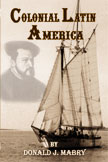The
inhabitants of the New World had no serious infectious diseases which were transferable to
Europeans or Africans except, perhaps syphilis,
but New World peoples they had no immunity to African and European diseases. Because of this, there was a demographic
disaster in the Americas. Microbes, not humans, conquered the New World.
The
scope of the disaster reflected the dense population
population of central Mexico and the highlands of the Andes. The two most important
American food crops, maize (corn
) and potatoes, were more
productive of calories per acre than any Old World crops except rice. This
allowed denser populations per square mile than anywhere except East Asia
. The American population
may have been 100 million persons with 25-30 million in central and
southern Mexico and an equal amount in the Andean highlands. By 1568,
however, the population of central Mexico had dropped to 3 million; by 1620,
1.6 million. Disease spread silently and rapidly. For example, there were some 6,000-8,000 Cayapo in South America in 1903 when a single
priest arrived. He wanted to safeguard them from the evils and dangers of
civilization but he did not realize that he was introducing contagious disease into a population which had no immunity. By 1918, only
500 Cayapo survived; by 1927, only 27. By 1950, there were only 2 or 3.
Faith
in established institutions and beliefs cannot easily withstand such disaster.
Skills and knowledge disappear. There was wholesale demoralization and simple
surrender of will. Although Europe and Africans did not do this
intentionally, modern biological terrorists understand these effects.
In
America, the rapid spread of these fatal diseases created labor shortages and
economic regression. The population decline destroyed the requerimiento. Haciendas became more attractive to
Spaniards and Amerinds alike. They provided a haven for the native population and made
them easier to control and work.
Smallpox
was in Hispaniola by 1518. Las Casas said that only one thousand
survived the epidemic. It reached Mexico
in 1520 when Pánfilo de Narváez arrived. Between the time of Moctezuma's death and La Noche Triste
in 1520, smallpox raged in Tenochtitlán. Leaders died within hours of
Cortez'
retreat. The Aztecs
were beaten by smallpox long before they were beaten by Cortez. By
1520, smallpox had also spread to Guatemala. By 1525 or 1526, it was
killing people in the Inca empire. Pizarro and his men found a population devastated by this
deadly disease
. The Spanish were immune,
giving credence to their claims of superiority. Both the Spanish and the
Amerinds saw the
smallpox pandemic as divine punishment for the Amerind way of life. Stunned
acquiescence to Spanish "superiority" was seen as the only possible
response.
Other
diseases were also devastating. Measles were in Mexico and Peru by 1530-31.
Typhus may have come to the New World by 1546. There was an influenza epidemic in 1558-59; the European epidemic lasted from 1556
to 1560 and killed 20% of England's population. The Amerinds also had to withstand diphtheria and mumps epidemics. A German missionary in 1699 observed
"The Indians die so easily that the bare look and smell of a Spaniard
causes them to give up the ghost." Breath instead of smell would have been
more accurate! The Amerinds were also inflicted with the African diseases of yellow fever and malaria. Yellow fever came to the
Caribbean from West Africa in 1648, hitting Havana and the Yucatán peninsula.
As
one Amerind observed:
Great was the stench of death. After our fathers
and grandfathers succumbed, half the people
fled to the fields. The dogs and vultures
devoured the bodies. The mortality was terrible.
Your grandfathers died, and with them died the
son of the king and his brothers and kinsmen.
So it was that we became orphans, oh, my sons!
So we became when we were young.
All of us were thus. We were born to die!
© 2001 Donald J. Mabry
You can read about colonial Latin American history by buying and reading
 Colonial Latin America by Don Mabry.
Colonial Latin America by Don Mabry.
Click on the book cover or the title to go to Llumina Press.